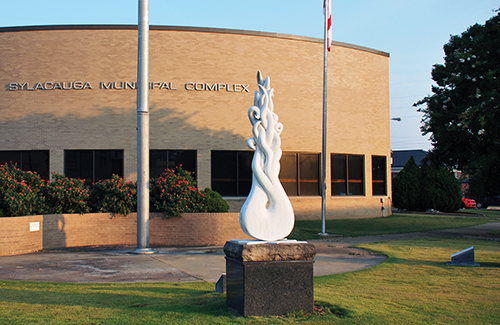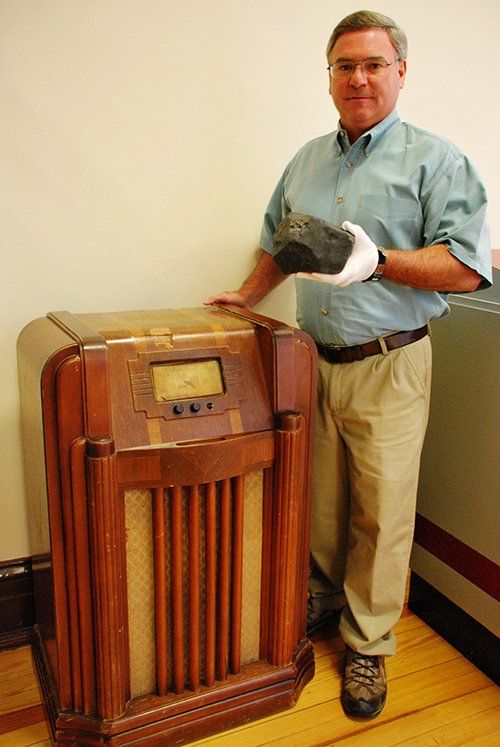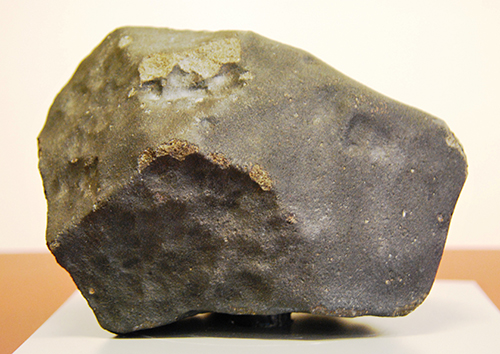60 years later
By Emmett Burnett

Photo by Emmett Burnett
Ann Hodges was napping in her living room when the meteorite hit. With an estimated speed exceeding 200 mph, the grapefruit-sized intergalactic rock punctured her roof, bounced off a radio console, and hit the Sylacauga woman in the thigh and hand. She recovered from the injury but never overcame the visitor from outer space. Sixty years have passed since Sylacauga’s collision course. On Nov. 30, 1954, around lunchtime, townspeople heard a massive explosion. Many thought it was a nearby factory. Some believed it was the Russians. No one expected an incoming meteor, until they looked up. Former Alabama Natural History Museum Assistant Director (retired) Dr. John C. Hall was the curator of the rock. He has lectured frequently about Sylacauga’s close encounter. “People actually witnessed the space phenomenon in the middle of day, broad daylight,” he recalled. “It was visible in Tuscaloosa, well over 100 miles away.” The Birmingham News reported a heavenly fireball almost in unison with the explosion, witnessed in three states. Scientists theorized it was a sonic boom created by a meteorite’s traveling faster than the speed of sound: destination, Sylacauga.
Thirty-one-year-old Ann Hodges had a different perspective. “I thought my time had come,” she told the media. In a way, she was right.

“Mrs. Hodges was a small town, country girl,” says Hall. “There was no one more unqualified to handle the media onslaught than she was.” Life Magazine featured her as did National Geographic. She was flown to New York City to appear on the nationally televised game show, I’ve Got a Secret. The Hodges meteorite not only invaded her home, it invaded her life.
“You have to remember, this was 1954,” Hall continued. “There was no text messaging or internet. News was slow. Back then most people’s knowledge of outer space was from science fiction movies. Add to that we were in the middle of the Cold War with Russia and UFO sightings.” People assumed the worst, and so did the United States Air Force.
Hours after the meteorite hit, a military helicopter landed at a nearby high school campus. Officers demanded Hodges surrender her piece of the rock. She did.
It was transported to Ohio’s Wright-Patterson Air Force Base for analysis. After careful study, military scientists concluded it was a meteorite. Meanwhile, Hodges and husband Hewlett realized the potential to make money from their new found fame. The meteorite could be worth a fortune. Hodges’ landlady, Birdie Guy, agreed, but felt the stone belonged to her. Everyone hired lawyers.
Guy claimed that since the object crashed through her property she was the rightful owner. After many expensive legal battles, the court agreed. But by then, interest waned and both parties had strained savings for legal fees. The landlady sold the meteorite back to Hodges in 1955 for $500. Sylacauga’s extraterrestrial, which one year earlier caused a local panic, was seized by the military and received worldwide press coverage, was now the Hodges’ home doorstop. An Indiana attorney representing Washington D.C.’s Smithsonian Institution visited. He unsuccessfully attempted to negotiate a selling price for the meteorite with Hewlett Hodges. “But Hewlett felt the Yankee attorney was trying to take advantage of him with a low price offer,” says Hall. “The two had words and the attorney left.” But not quite.

Photo by Emmett Burnett
Julius K. McKinney, an African-American sharecropper, lived nearby. Shortly after the Hodges meteorite crashed, McKinney was driving his mule wagon down a dirt road when suddenly the animals stopped. Shaken, jittery, and nervous, the mules refused to pass a small black stone in the road. McKinney took the mysterious rock to the only federal employee he trusted, his mailman. The two concluded the acquisition must be related to the Hodges meteorite and might be worth a lot of money. McKinney lawyered up. After the rock was authenticated, he sold it for an undisclosed sum but enough to buy a new house, new car, and property. “McKinney was the only one to ever profit from the meteorite,” Hall says. And the McKinney meteorite remains in the Smithsonian Institution to this day. Estimated to be as old as recorded time, the Hodges meteorite is still displayed at the Alabama Museum of Natural History in Tuscaloosa. “It is our wow factor,” said the museum’s director, Randy McCready, about the mysterious black object that traveled millions of miles before stopping in Alabama. “Even six decades later we receive inquiries from around the world.” The 7 by 5-inch oblong other-worldly rock has an almost eerie presence, resting by the Hodges radio with its 1954 damage marks clearly visible. “Ann thought it was cursed,” says McCready. Maybe it was. In 1967 Ann and Hewlett Hodges divorced, due in part to stress caused by the incident, publicity and litigation. Both agreed they wished the rendezvous with space never happened. She died in 1972 at age 49. Hewlett Hodges died in 2011. Ann Hodges is the only authenticated person ever struck by a meteorite. Her Decatur physician, Dr. Moody Jacobs, is the only known medical responder to treat a meteorite injury. The Hodges home, featured in press coverage around the world because of something outside the world, has long been demolished. Ironically, the home stood near the Comet Drive-In Movie Theater. But a statue, ‘Falling Star,’ stands on the grounds of the Sylacauga Municipal Complex. Sculpted from the area’s fine marble by artist Don Lawler, it is the only known monument in the world dedicated to a meteorite strike, the day stars fell on Alabama.




